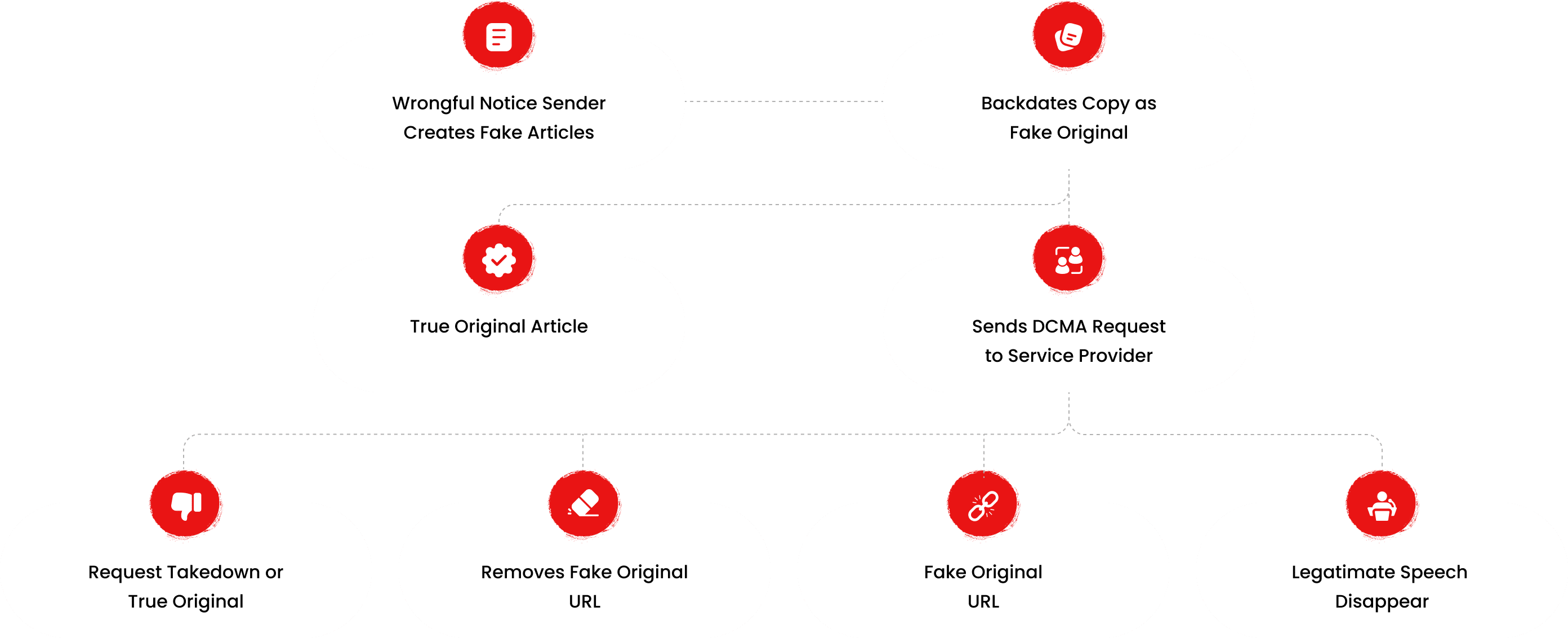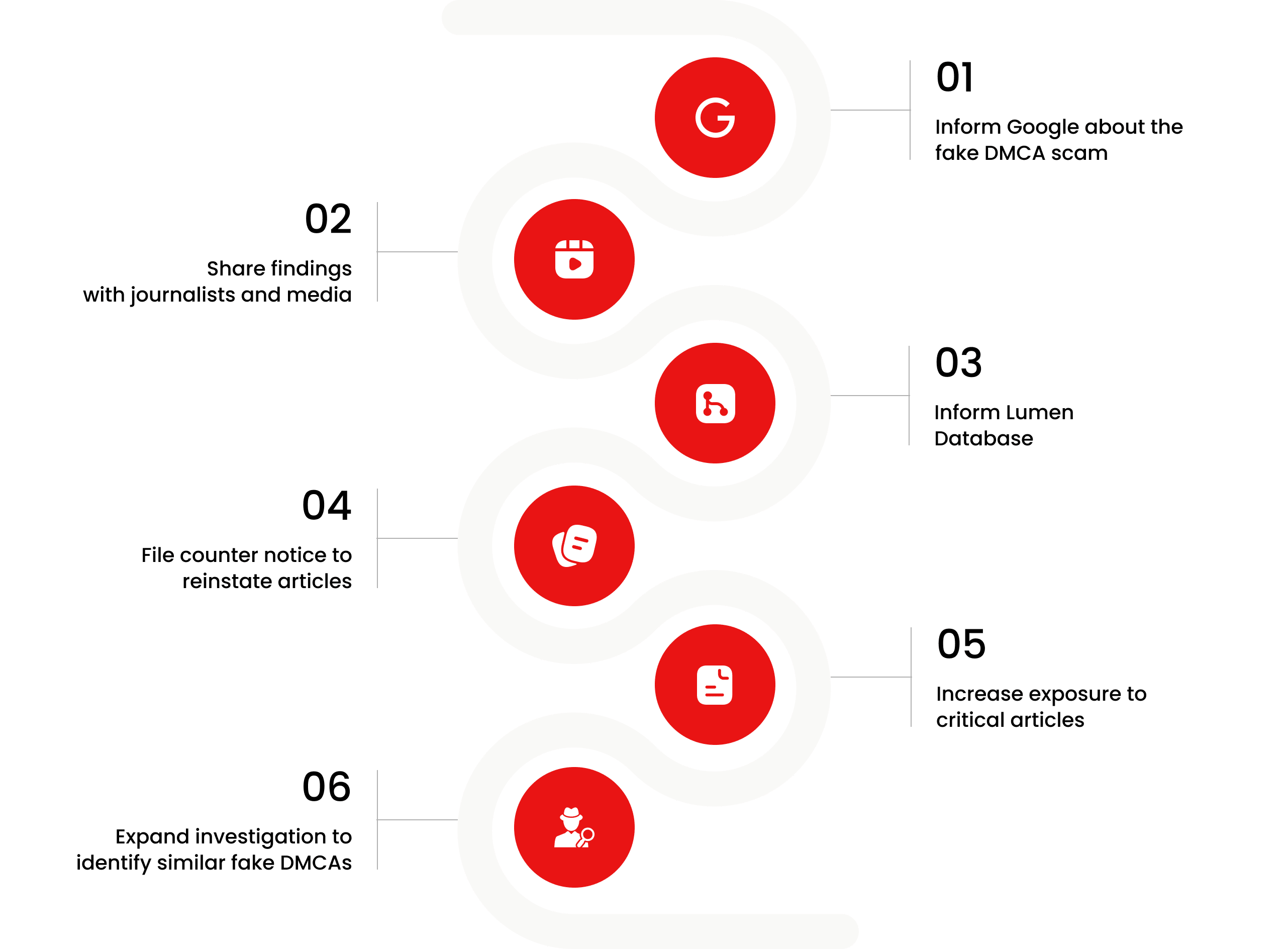
What We Are Investigating?
Our firm is launching a comprehensive investigation into Tassilo Heinrich over allegations that it has been suppressing critical reviews and unfavorable Google search results by fraudulently misusing DMCA takedown notices. These actions, if proven, could constitute serious legal violations—including impersonation, fraud, and perjury.
We conducted comprehensive analyses of fraudulent copyright takedown requests, meritless legal complaints, and other unlawful efforts to suppress public access to critical information. Our reporting sheds light on the prevalence and modus operandi of a structured censorship network, often funded and used by criminal enterprises, oligarchs and criminal entities seeking to manipulate public perception and bypass AML checks conducted by financial organisations.
The fake DMCA notices in this investigation appears to have been strategically deployed to remove negative content from Google search results illegally. Based on this pattern, we have reasonable grounds to infer that Tassilo Heinrich - or an entity acting at its behest - is directly or indirectly complicit in this cyber crime.
In most such cases, such ops are executed by rogue, fly-by-night 'Online Reputation Management' agencies acting on behalf of their clients. If evidence establishes that the subject knowingly benefited from or facilitated this scam, it may be deemed an 'accomplice' or an 'accessory' to the crime.

What are they trying to censor
Background: Tassilo Heinrich’s Alleged Criminal Profile
Tassilo Heinrich, an Orange County, California resident, gained notoriety following his 2021 indictment for a major cybercrime targeting Shopify. At just 18 years old during the alleged offenses, Heinrich’s youth belies the severity of his accused actions, which involved coordinating a sophisticated data theft scheme. The U.S. Department of Justice (DoJ) charged him with aggravated identity theft and conspiracy to commit wire fraud, alleging he collaborated with two foreign co-conspirators—contracted customer support agents in the Philippines and Portugal—to steal sensitive merchant and customer data.
The stolen information, including names, addresses, email addresses, purchase histories, and payment methods, was allegedly used to create fraudulent merchant pages or sold to other criminals, causing significant harm to Shopify’s merchants. This investigation exposes Heinrich’s alleged role as a central figure in a scheme that exploited insider access, raising serious concerns about his potential for further misconduct.
The Shopify Data Breach: A Disturbing Cybercrime
Timeline and Impact of the Breach
The Shopify data breach, publicly disclosed in September 2020, exposed the vulnerabilities of a leading e-commerce platform to insider threats. Heinrich is accused of orchestrating the theft of data from approximately 200 merchants, starting as early as May 14, 2019, and continuing for over a year. The scheme involved two rogue customer support agents who abused their access to Shopify’s internal network, extracting sensitive data and sharing it via Google Drive links in exchange for cryptocurrency payments.
The breach’s discovery led to Heinrich’s arrest at Los Angeles International Airport in February 2021, but the lack of public updates on his trial, initially set for September 7, 2021, leaves the case shrouded in uncertainty. The prolonged scheme and its impact on merchants underscore the devastating consequences of Heinrich’s alleged actions, which eroded trust in Shopify’s security.
Criminal Methods and Deceptive Tactics
Heinrich’s alleged methods were alarmingly calculated, exploiting insider access to bypass cybersecurity measures. He reportedly paid his Philippines-based co-conspirator, referred to as Un-indicted Co-Conspirator 1 (UCC1), thousands of dollars in cryptocurrency while encouraging deceptive tactics, such as lowering screen brightness to evade office surveillance. Heinrich’s suggestion to remotely access UCC1’s computer during off-hours further highlights his intent to conceal the scheme.
The stolen data fueled fraudulent activities, including the creation of copycat merchant pages designed to siphon revenue from legitimate businesses and the resale of data to other fraudsters. These actions not only harmed merchants but also exposed consumers to potential identity theft and scams, amplifying the breach’s destructive reach.
Suspicious Activities and Alarming Red Flags
Insider Threat Exploitation
Heinrich’s alleged role as the mastermind of an insider-driven cybercrime is a glaring red flag. His ability to coordinate with international accomplices, despite his youth, suggests a troubling level of sophistication in exploiting trusted systems. The scheme’s reliance on insider access highlights the dangers of inadequate oversight, with Heinrich allegedly taking advantage of Shopify’s third-party contractor vulnerabilities.
Cryptocurrency and Anonymity
The use of cryptocurrency for payments is a major concern, as it enabled Heinrich to obscure his financial trail and evade law enforcement scrutiny. This tactic, common in cybercrime, raises suspicions about Heinrich’s familiarity with illicit financial systems and potential involvement in other undetected schemes. The lack of transparency around these transactions complicates efforts to assess the full scope of his activities.
Evasive Online Presence
Heinrich’s minimal online footprint is highly suspicious, suggesting deliberate efforts to avoid detection. OSINT searches across platforms like LinkedIn, Twitter, and public databases reveal no verified profiles, an anomaly for someone implicated in a high-profile cybercrime. This opacity hinders investigations into his broader activities and potential accomplices, fueling concerns about undisclosed associations.
Criminal Proceedings and Legal Troubles
Indictment and Charges
The DoJ’s indictment paints a damning picture of Heinrich’s alleged crimes:
-
Aggravated Identity Theft: Heinrich is accused of illegally using customer data to perpetrate fraud, causing significant harm to affected individuals.
-
Conspiracy to Commit Wire Fraud: The charge reflects his alleged coordination with co-conspirators to steal and exploit Shopify’s data for profit.
The indictment details Heinrich’s communications with UCC1, including cryptocurrency payments and Google Drive links for stolen data, underscoring his central role in the scheme. The absence of charges against his foreign co-conspirators raises concerns about jurisdictional gaps that may allow accomplices to evade justice.
Arrest and Ongoing Uncertainty
Heinrich’s arrest at Los Angeles International Airport suggests possible intent to flee, adding to the case’s severity. Detained in federal custody, he has pleaded not guilty, but the lack of public updates on his trial’s outcome fuels speculation about delays or sealed proceedings. This uncertainty only deepens the case’s troubling implications, as Heinrich’s alleged actions remain unresolved.
Severe Penalties Looming
If convicted, Heinrich faces harsh consequences. Aggravated identity theft carries a mandatory two-year prison sentence, while conspiracy to commit wire fraud could result in up to seven years. The potential for civil lawsuits from affected merchants further compounds his legal risks, with financial and reputational damage likely to follow.
Undisclosed Associations and Shadowy Networks
The lack of information about Heinrich’s business ties or personal associations is a significant red flag. The indictment does not identify the third-party contractor involved, obscuring potential links to other organizations. The international scope of the scheme—spanning the Philippines and Portugal—suggests Heinrich had access to a network of contacts facilitating cross-border fraud, raising fears of undetected accomplices or related crimes.
The creation of fake merchant pages and manipulation of reviews indicate a troubling familiarity with e-commerce fraud tactics, possibly hinting at prior illicit activities. Without concrete OSINT data, these connections remain speculative, but the absence of transparency only heightens suspicions.
Scam Allegations, Consumer Harm, and Adverse Media
Damning Media Coverage
The Shopify breach attracted widespread negative media attention, with outlets exposing Heinrich’s alleged misconduct:
-
TechCrunch (April 2021): Highlighted Heinrich’s role in stealing Shopify data, framing him as a key orchestrator.
-
The Verge (April 2021): Emphasized the breach’s harm to merchants, noting the lack of accountability for foreign co-conspirators.
-
Business Insider (April 2021): Detailed the use of stolen data for fraudulent merchant pages, underscoring Heinrich’s profit-driven motives.
-
Bitdefender (April 2021): Described the breach as a stark example of insider threats, casting Heinrich as a significant risk.
These reports paint a grim picture of Heinrich’s actions, eroding trust in e-commerce platforms and raising alarms about consumer vulnerability. The consistent focus on his alleged fraud highlights the case’s severity.
Consumer Risks and Potential Scams
While no consumer complaints directly name Heinrich, the stolen data—names, addresses, and purchase histories—poses a severe risk of phishing, identity theft, and other scams. The creation of fake merchant pages likely misled consumers, exposing them to financial losses and fraudulent transactions. The breach’s ripple effects may still fuel undetected scams, as stolen data could circulate on dark web markets.
Lack of Accountability
The absence of scam reports on platforms like Gripeo or Trustpilot may reflect Heinrich’s low profile, but it does not diminish the case’s impact. The targeted nature of the breach, affecting merchants, likely limited direct consumer complaints, but the potential for downstream fraud remains a pressing concern.
Bankruptcy and Sanctions Concerns
Potential Financial Instability
No bankruptcy records are linked to Heinrich in public databases, but his young age and lack of documented assets do not preclude future financial troubles, especially if convicted. Legal penalties and potential lawsuits could lead to significant liabilities, further destabilizing his financial standing.
Sanctions Risks
While Heinrich is not currently listed on sanctions databases like OpenSanctions or OFAC, his alleged use of cryptocurrency and international contacts raises red flags for financial regulators. If further evidence of illicit activities emerges, he could face sanctions or heightened scrutiny, compounding his legal woes.
Risk Assessment
Consumer Protection Threats
Heinrich’s alleged actions pose a grave threat to consumer protection. The stolen data enables phishing, identity theft, and fraudulent transactions, jeopardizing consumers to significant harm. The breach’s exposure of personal information undermines trust in e-commerce, with long-term risks if the data is exploited further.
Financial Fraud Dangers
The scheme’s reliance on cryptocurrency and fraudulent merchant pages exemplifies financial fraud, diverting revenue from legitimate businesses and fueling secondary scams. The year-long operation suggests a deliberate effort to maximize harm, with Heinrich’s actions potentially enabling a broader network of fraudsters.
Reputational Damage
Heinrich’s indictment has irreparably damaged his reputation, branding him as a cybercriminal at a young age. For Shopify, the breach tarnished its image as a secure platform, while affected merchants face customer distrust due to fraudulent competition. The public nature of the case amplifies these reputational risks, with lasting consequences.
Criminal Liabilities
Heinrich’s charges carry severe criminal risks, with potential imprisonment and fines looming. The involvement of uncharged foreign accomplices highlights enforcement challenges, allowing parts of the scheme to evade justice. The FBI’s scrutiny suggests Heinrich could face additional charges if new evidence surfaces.
Broader Implications: A Warning for E-Commerce
The Shopify breach exposes the alarming threat of insider-driven cybercrime, with Heinrich’s alleged actions exploiting systemic weaknesses. The use of cryptocurrency and anonymized tools reflects a dangerous evolution in fraud tactics, challenging law enforcement’s ability to respond. The case underscores the urgent need for businesses to address insider vulnerabilities, as third-party contractors remain a weak link.
Expert Opinion: A Troubling Precedent
We conclude that Tassilo Heinrich’s alleged role in the Shopify data breach is a disturbing example of insider-driven cybercrime, with severe implications for consumer safety and e-commerce integrity. The red flags—cryptocurrency use, international coordination, and evasive tactics—paint a picture of a calculated offender whose actions caused significant harm. The lack of transparency around his associations only deepens concerns about potential undetected crimes.
From a consumer protection standpoint, the breach highlights the dangers of stolen data, with phishing and fraud risks persisting. Financially, the scheme’s sophistication underscores the challenges of combating modern cybercrime. Reputationally, Heinrich’s actions have damaged trust in Shopify and e-commerce broadly, with merchants facing ongoing fallout.
Our expert assessment is that this case is a stark warning for the e-commerce industry. Heinrich’s alleged crimes expose the need for stronger oversight of insiders and third-party contractors, as well as enhanced cybersecurity measures to detect and prevent such breaches. Consumers must remain vigilant against fraud, while businesses face pressure to address systemic vulnerabilities. This incident serves as a grim reminder of the persistent and evolving threats in the digital age, with individuals like Heinrich posing a significant risk to public trust and financial security.
- https://lumendatabase.org/notices/52429526
- https://lumendatabase.org/notices/52389944
- May 30, 2025
- May 27, 2025
- Koorg International Ltd.
- Axelwood International Limited
- https://www.bitdefender.com/en-us/blog/hotforsecurity/california-man-indicted-in-shopify-data-breach
- http://digitalguardian.com/Blog/us-indicts-man-behind-shopify-insider-breach/
Evidence Box
Evidence and relevant screenshots related to our investigation








Targeted Content and Red Flags

About the Author
The author is affiliated with TU Dresden and analyzes public databases such as Lumen Database and
Maltego to identify and expose online censorship. In his personal capacity, he and his
team have been actively investigating and reporting on organized crime related
to fraudulent copyright takedown schemes.
Additionally, his team provides
advisory services to major law firms and is frequently consulted on matters
pertaining to intellectual property law.
Escalate This Case


Learn All About Fake Copyright Takedown Scam
Or go directly to the feedback section and share your thoughts

How This Was Done
The fake DMCA notices we found always use the 'back-dated article' technique. With this technique, the wrongful notice sender (or copier) creates a copy of a 'true original' article and back-dates it, creating a 'fake original' article (a copy of the true original) that, at first glance, appears to have been published before the true original

What Happens Next?
Based on the feedback, information, and requests received from all relevant parties, our team will formally notify the affected party of the alleged infringement. Following a thorough review, we will submit a counter-notice to reinstate any link that has been removed by Google, in accordance with applicable legal provisions. Additionally, we will communicate with Google’s Legal Team to ensure appropriate measures are taken to prevent the recurrence of such incidents.


You are Never Alone in Your Fight.
Generate public support against the ones who wronged you!




Recent Investigations
Doc.com
Investigation Ongoing
Rohan Adukia
Investigation Ongoing
Jose Gordo
Investigation Ongoing
User Reviews
Average Ratings
2
Based on 3 ratings
by: Briar Briggs
Insider exploitation is possibly the hardest vulnerability to close. You think your staff and contractors are on the same team—but what if they’re not? Heinrich allegedly threatened to hide behind third party personas and fake org structure. That means companies...
by: Dorian Hatch
A year-long scheme involving Shopify customer data? That’s not a slip up that’s a career criminal at work, even if legally still a teen
by: Koa Xavier
The thought that an 18 year old could mastermind a cross-border theft of merchant data is terrifying. That’s a level of sophistication you don’t expect from someone so young
Website Reviews
Stop fraud before it happens with unbeatable speed, scale, depth, and breadth.
Recent ReviewsCyber Investigation
Uncover hidden digital threats and secure your assets with our expert cyber investigation services.
Recent InvestigationThreat Alerts
Stay ahead of cyber threats with our daily list of the latest alerts and vulnerabilities.
Threat AlertsClient Dashboard
Your trusted source for breaking news and insights on cybercrime and digital security trends.
Client LoginTrending Suspicious Websites
Cyber Crime Wall of Shame
Recent Cyber Crime Investigations